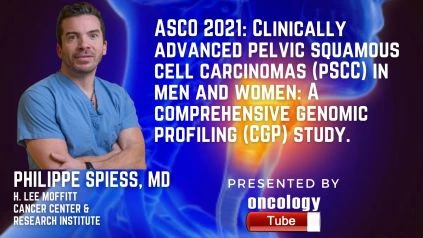Philippe Spiess, MD from H. Lee Moffitt Cancer Center & Research Institute speaks about the ASCO 2021 Abstract – Clinically advanced pelvic squamous cell carcinomas (pSCC) in men and women: A comprehensive genomic profiling (CGP) study.
Link to Abstract:
https://meetinglibrary.asco.org/record/197709/abstract
Background:
We used CGP to look for probable genetic changes between tumor types because the clinical symptoms, disease course, and treatment choices for pSCC varied.
Methods:
1,741 clinically advanced pSCCs underwent hybrid capture-based CGP to evaluate all classes of genomic alterations, including 230 penile (penSCC), 17 male urethral (murthSCC), 125 male anal (manSCC), 7 female urethral (furthSCC), 263 vulvar (vulSCC), 822 cervical (crvSCC), and 277 female anal SCCs (fanSCC) (GAs). Microsatellite instability (MSI) was measured on up to 114 loci and tumor mutational burden (TMB) was evaluated on up to 1.1 Mb of sequenced DNA. IHC was used to detect PD-L1 expression (Dako 22C3).
Results:
MurthSCC and vulSCC had the lowest HPV-16/18 detection, whereas manSCC, fanSCC, and crvSCC had the most. The presence of TP53 GAs was shown to be negatively related to the presence of HPV. The frequency of PIK3CA GA changed throughout time (22-43 percent ). The number of DNA-damage response (DDR) GAs (e.g., BRCA1/2, ATM, and others) was low ( 1-3%) throughout the study. GAs related to the cell cycle were most common in external instances (penSCC, furthSCC, vulSCC). The GAs of the MTOR pathway (PTEN, FBXW7) was the most commonly discovered “actionable†GAs. Other receptor-tyrosine kinase (RTK) targeted alternatives were present in 1% of murthSCC, crvSCC, and fanSCC; other receptor-tyrosine kinase (RTK) targeted options were present in 1% of BRAF/ERBB2. NOTCH1 GAs were found in more than 15% of penSCC and vulvSCC samples. In manSCC, fanSCC, and crvSCC, TMB 10 mut/Mb was >15 percent. All pSCC except crvSCC had low expression of PD-L1, and all pSCC except urthSCC and manSCC had high expression of PD-L1.
Conclusions:
Despite having similar histology, pSCC varied significantly in terms of GAs and HPV status. The most common “targetable†GA is PIK3CA, which is followed by the MTOR pathway and the cell cycle; RTK targets are exceedingly rare. Given the rarity of DDR GAs, PARP inhibitor choices appear to be limited. Based on TMB>10 mut/Mb and PD-L1 expression, anti-PD(L)1 might be explored in a number of situations.

